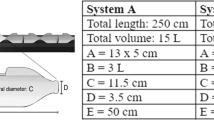Abstract
The avoidance responses of juvenile striped bass (Morone saxatilis) were evaluated by exposing test organisms to simultaneous elevated temperature (0, 2, 4, and 6‡C) and total residual chlorine (TRC) (0.00, 0.05, 0.10 and 0.15 mg/L) conditions at four acclimation temperatures ranging from 15–30‡C. An unbalanced 3-factor factorial design was used to develop response surface avoidance models at all acclimation temperatures. The percent avoidance models at 15‡C showed that the interaction term (TRC×δT) was the most important term influencing avoidance; TRC was the most important factor at 20‡C; the models at 25 and 30‡C showed that δT was the most important factor. The results of tests conducted at 15‡C suggest that preference for a higher temperature overrides a chlorine avoidance response to 0.15 mg/L TRC. Avoidance responses of striped bass tested at acclimation temperatures of 20, 25, and 30‡C showed that preference for a higher temperature (6‡C δT) did not override a chlorine avoidance response. A significant difference (p<0.01) existed between avoidance models at all acclimation temperatures; greatest avoidance generally occurred for all combinations of test conditions at 30‡C.
Similar content being viewed by others
References
American Water Works Association and Water Pollution Control Federation: Standard methods for the examination of water and wastewater, 14 ed. Washington, DC:American Public Health Association (1976).
Chadwick, H. K.: Entrainment and thermal effects of a mysid shrimp and striped bass in the Sacramento-San Joaquin delta In L. D. Jensen (ed.): Proceedings of the second workshop on entrainment and intake screening, p. 23. Baltimore, MD:The Johns Hopkins University (1974).
Dixon, W. T., and M. B. Brown: Biomedical computer program p-series. Berkeley, CA:University of California Press (1979).
Draper, N. R., and H. Smith. Applied regression analysis. New York:John Wiley and Sons (1981).
Eichorn, K. L.: The response of striped bass (Morone saxatilis) to heated and chlorinated power plant effluent. New York:Masters Thesis, New York University (1977).
Giattina, J. D., D. S. Cherry, J. Cairns, Jr., and S. R. Larrick: Comparison of laboratory and field avoidance behavior of fish in heated chlorinated water. Trans. Am. Fish. Soc.110, 526 (1981).
Hall, L. W., Jr., W. C. Graves, D. T. Burton, S. L. Margrey, F. M. Hetrick, and B. S. Roberson: A comparison of chlorine toxicity to three life stages of striped bass,Morone saxatilis. Bull. Environ. Contam. Toxicol.29, 631 (1982).
Klauda, R. J., W. P. Dey, T. B. Hoff, J. B. McLaren, and Q. E. Ross: Biology of Hudson River striped bass. In H. Clepper (ed): Marine recreational fisheries, p. 101. Washington, DC:Sport Fishing Institute (1980).
Kohlenstein, L. C.: On the proportion of the Chesapeake Bay stock of striped bass that migrates into the coastal fishery. Trans. Am. Fish. Soc.110, 168 (1981).
Marcy, B. C., and R. C. Galvin: Winter-spring sport fishery in the heated discharge of a nuclear power plant. J. Fish Biol.5, 541 (1973).
Meldrim, J. W., and J. A. Fava, Jr.: Behavioral avoidance responses of estuarine fishes to chlorine. Chesapeake Sci.18, 154 (1977).
Meldrim, J. W., and J. J. Gift: Temperature preference, avoidance, and shock experiments with estuarine fishes. Middletown, DE: Bulletin No. 7, Ichthyological Associates, Inc. (1971).
Meldrim, J. W., J. J. Gift, and B. R. Petrosky: The effect of temperature and chemical pollutants on the behavior of several estuarine organisms. Middletown, DE:Bulletin No. 11, Ichthyological Associates, Inc. (1974).
Middaugh, D. P., J. A. Couch, and A.M. Crane: Responses of early life history stages of the striped bass,Morone saxatilis to chlorination. Chesapeake Sci.18, 141 (1977).
Osborne, L. L., D. R. Iredale, F. J. Wrona, and R. W. Davies: Effects of chlorinated sewage effluents on fish in the Sheep River, Alberta. Trans. Am. Fish. Soc.110, 536 (1981).
Pearson, W. H., and B. L. Olla: Detection of naphthalene by the blue crab,Callinectes sapidus. Estuaries2, 64 (1979).
Public Service Electric and Gas Company: Comparative evaluation of effects of ozonated and chlorinated thermal discharges on estuarine and fresh water organisms. Newark, NJ:Report USDOE DE-AC02-77EUO4384, Public Service Electric and Gas Company (1980).
Shelford, V. E., and W. C. Allee: The reactions of fishes to gradients of dissolved atmospheric gases. J. Exp. Zool.14, 207 (1913).
Sprague, J. B., and D. E. Drury: Avoidance reactions of salmonid fish to representative pollutants. In S. H. Jenkins (ed): Advances in water pollution research, p. 169. Oxford, England:Pergamon Press (1969).
Stauffer, J. R., Jr., K. L. Dickson, J. Cairns, Jr., and D. S. Cherry: The potential and realized influence of temperature on the distribution of fishes in the New River, Glen Lyn, Virginia. Louisville, KY: Wildl. Monog. No. 50 (1976).
Stober, Q. J., P. A. Dinnel, E. F. Hurlburt, and D. H. DiJulia: Acute toxicity and behavioral responses of coho salmon (Oncorhynchus kisutch) and shiner perch (Cymatogaster aggregata) to chlorine in heated seawater. Water Res.14, 347 (1980).
Terpin, K. M., M. L. Wyllie, and E. R. Holmstrom: Temperature preference, avoidance, shock, and swim speed studies with marine and estuarine organisms from New Jersey. Newark, NJ: Bulletin No. 17, Ichthyological Associates, Inc. (1977).
Author information
Authors and Affiliations
Rights and permissions
About this article
Cite this article
Hall, L.W., Margrey, S.L., Burton, D.T. et al. Avoidance behavior of juvenile striped bass,Morone saxatilis, subjected to simultaneous chlorine and elevated temperature conditions. Arch. Environ. Contam. Toxicol. 12, 715–720 (1983). https://doi.org/10.1007/BF01060756
Received:
Revised:
Issue Date:
DOI: https://doi.org/10.1007/BF01060756




